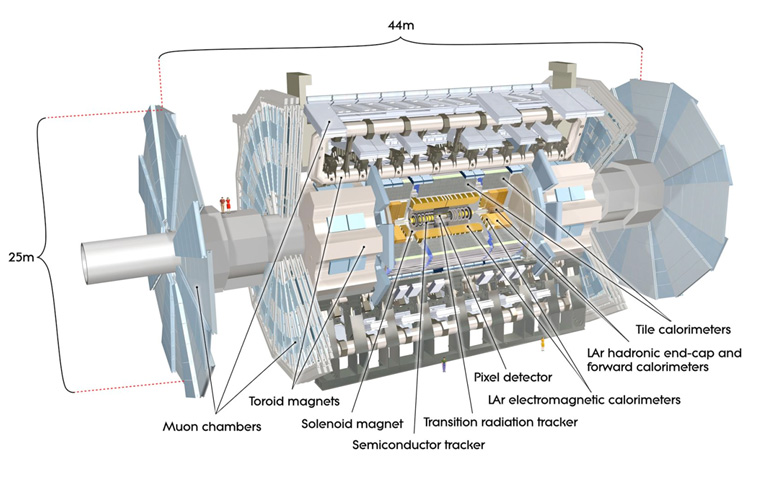ATLAS experiment


Diameter: 25 m
Length: 44 m
Weight: 7000 t
Length of the cables: 3000 km
ATLAS collaboration:
3000 scientists including 1000 graduates
from 191 institutions in 39 countries

Participants from Russian:
Institute for Theoretical and Experimental Physics (ITEP), Moscow; P.N. Lebedev Institute of Physics, Moscow; Moscow Engineering and Physics Institute (MEPhI), Moscow; Moscow State University, Moscow; Budker Institute of Nuclear Physics (BINP), Novosibirsk; State Research Center of the Russian Federation - Institute for High Energy Physics (IHEP), Protvino; Petersburg Nuclear Physics Institute (PNPI), St. Petersburg.
ATLAS (A Toroidal LHC ApparatuS) is one of four main experiments at LHC in CERN (Geneva, Switzerland). This experiment is conducted on a detector of the same name. It was built to study processes in highest-energy proton-proton and ion-ion collisions.
ATLAS is the largest general-purpose HEP facility in the world. It is located 100 meters underground, being 45 meters long, more than 25 meters in diameter (nine-storeyed building height), and weighs about 7000 tons. As most of the facilities with beams directed against each other, ATLAS has an “onion-layer” structure: its architecture changes as the distance from the interaction point increases. Semiconducting pixel and strip (SCT) detectors are located close to the center. Their role is precise measurement of charged particles coordinates and momenta near the primary interaction point. Those detectors are surrounded by transition radiation tracker (TRT), also used to measure tracks coordinates. Besides, TRT is used for electrons identification. All these detectors form so called Inner Detector. It is placed inside a superconducting magnet with solenoidal field strength 2 T. Inner Detector is surrounded by liquid argond based electromagnetic calorimeter to measure coordinates of electrons, positrons and photons. Next layer is hadronic calorimeter, which measures single hadrons and hadronic jets energy. Calorimeter system provides missing transverse energy measurement in case of energy disbalance. ATLAS is surrounded by an intense magnetic field provided by superconducting eight-section toroid in muon spectrometer barrel and endcaps. Three levels of muon chambers, which measure muons momenta, are located in the open structure of this toroid.
LHC has reached 8 TeV energy of colliding protons in center-of-momentum (COM) frame. It will start operating with 6.5-7 TeV beams (13-14 TeV in COM frame) and will reach its nominal luminosity 2*1034 cm-2 s-1 in 2015. Proton beams intersect with 40 MHz rate. More than fifty inelastic proton collisions take place in one intersection, more than one billion of these should be analyzed in a second. A three-level trigger system is used to select “interesting” collisions. Primary trigger is a large factory of ad-hoc manufactured processors, and its selection is hardware-based. Primary trigger passes one out of about 400 events (rate is up to 100 kHz). Second and third level triggers are software-based. Third-level trigger reconstructs physical event exploiting the same algorithms used for subsequent experimental data analysis. These triggers are yielded by factories consisting of almost two thousand computers. As a result, they write down about 500 events per second. Each of these events takes about one and a half megabytes. ATLAS collaboration has more than 36 thousand computers all around the world at its disposal for events analysis and simulation.

What does ATLAS experiment study?
The main goal of ATLAS experiment is an adjustment or a refutation of the Standard Model. The Standard Model is a theoretical construction in physics, which describes elementary particles and strong, weak and electromagnetic fundamental interactions, but not the gravitational one. It explains how the elementary particles interact but not why.
Main studies are focused on answering following questions:
- What is the origin of elementary particles masses? Why is it different for various particles?
- Why does visible matter make only 4% of the Universe? What is dark matter?
- What is the reason for asymmetry between matter and antimatter?
- Where are the Standard Model frontiers? Is there anything beyond these frontiers?
- Are there heavy partners of known particles (supersymmetry)?
- Are there other dimensions postulated in the string theory, which describes phenomena beyond the Standard Model and its simple extensions?
- Are there other fields and particles we do not know about?
- What are black holes? How are they formed and how do they decay (Hawking mechanism)?
ATLAS experiment will run till 2030, including operation with extremely high luminosities with 1010 interactions per second.
Thanks to the discovery of Higgs boson, today we have already received a partial answer to the first question. Higgs boson explains the mechanism of elementary particles masses acquisition. Theorists Peter Higgs and François Englert were awarded the Nobel Prize in 2013 for their prediction of this particle.
ATLAS and CMS experiments received many awards and medals.
More about ATLAS history and goals:
MEPhI input to the ATLAS experiment
Our group made large contribution to the TRT project - from first ideas and design to its creation, maintenance and physics results (more info).
Events related to Higgs boson production.
ATLAS facility
Contact Person:
Anatoli Romaniouk




